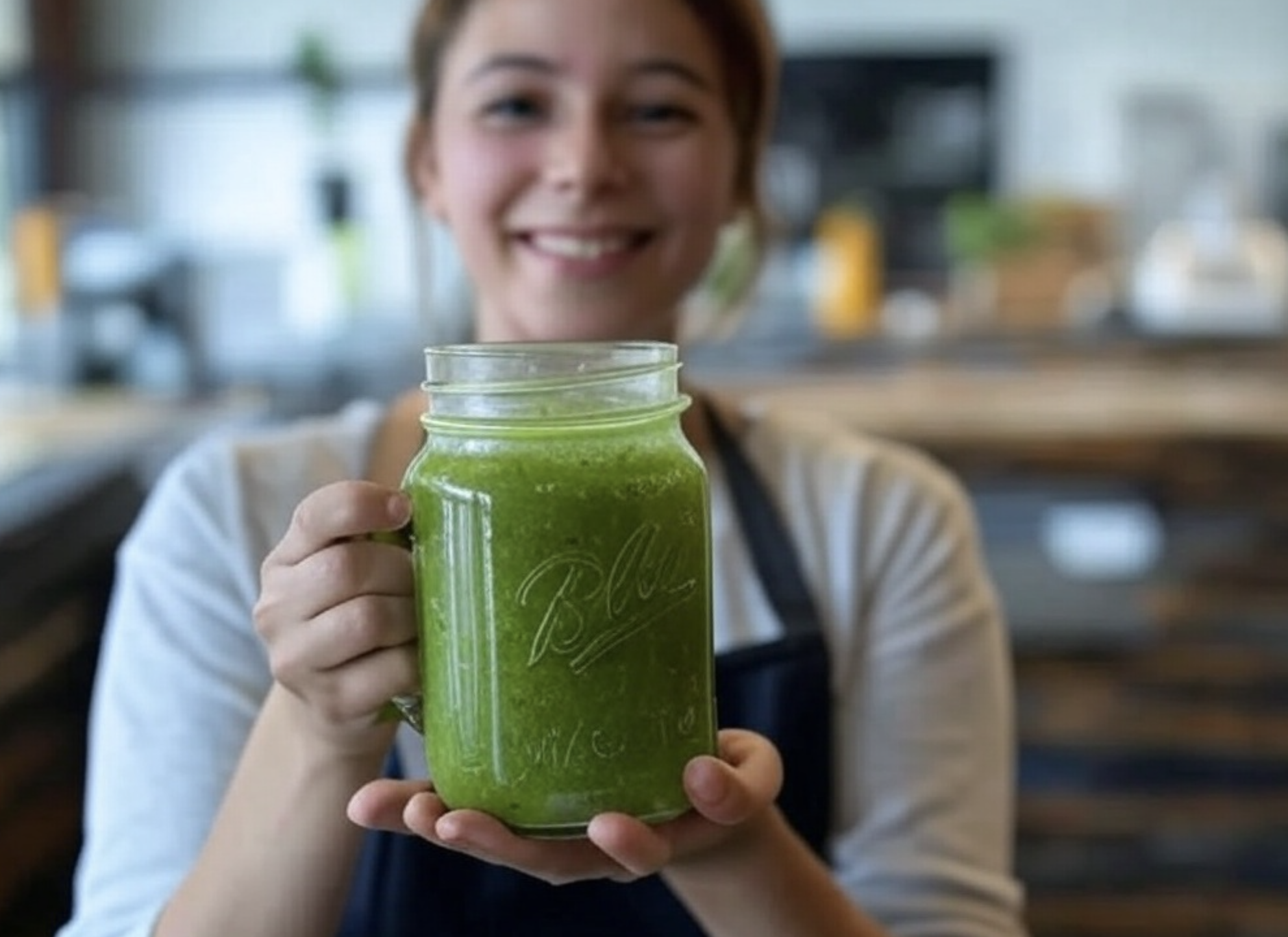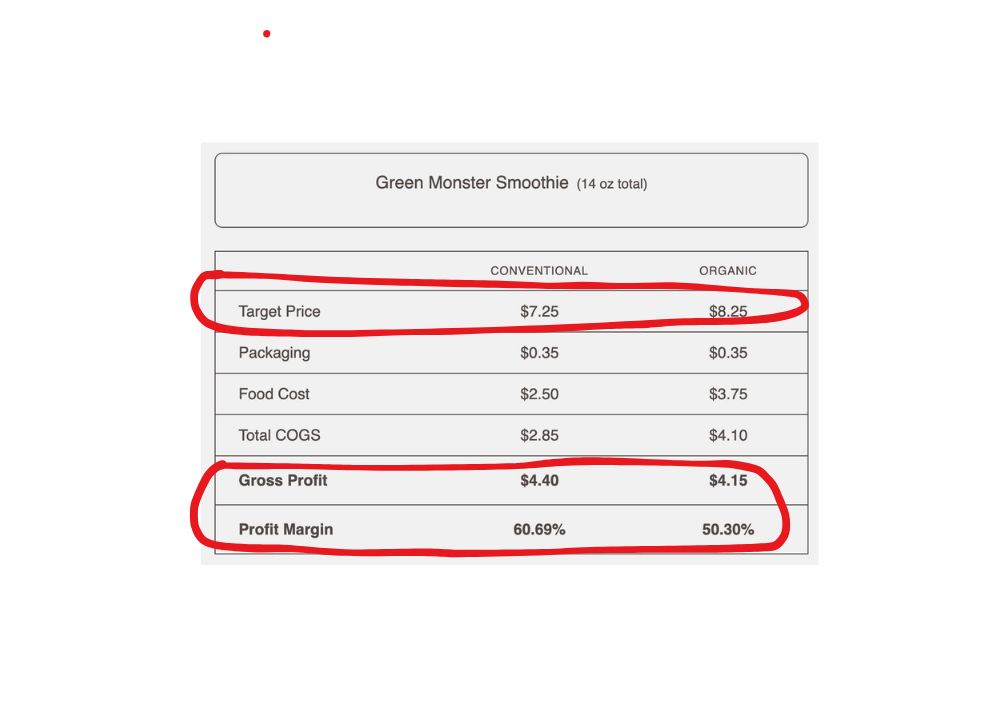Juice Profit Calculator and Recipe Scaling Tool
Juice & Smoothie Profit Calculator
Calculate the potential profit margin of your juice or smoothie recipes. Compare organic versus conventional ingredients and discover how to scale your recipes for different serving sizes.
Drink Information
Total Volume
14.0 oz
0/400 characters
Produce / Ingredient Cost
| Produce | Weight | Conventional Price ($) | Organic Price ($) | Actions |
|---|---|---|---|---|
$ | $ | |||
$ | $ | |||
$ | $ | |||
$ | $ | |||
$ | $ | |||
$ | $ | |||
$ | $ | |||
$ | $ | |||
$ | $ | |||
| Total: | $0.00 | $0.00 | ||
Tip: Click on an ingredient name or weight field to expand it for easier editing of longer text.
Note: Enter ingredients for a single serving. Costs will be automatically scaled based on the number of servings.
Packaging Cost
| Packaging | Price ($) | Units | Subtotal | Actions |
|---|---|---|---|---|
$ | $0.31 | |||
$ | $0.03 | |||
$ | $0.01 | |||
| Total: | $0.00 | |||
Results
Pricing and Profit
Untitled Drink(14 oz total)
| Conventional | Organic | |
|---|---|---|
| Target Price | $7.25 | $8.25 |
| Packaging | $0.00 | $0.00 |
| Food Cost | $0.00 | $0.00 |
| Total COGS | $0.00 | $0.00 |
| Gross Profit | $0.00 | $0.00 |
| Profit Margin | 0.00% | 0.00% |
Note: Most successful juice and smoothie businesses aim for a food cost percentage between 25-35%. A healthy profit margin typically falls between 60-75%.
Profit Per Day
| Servings Sold | Profit (Conventional) | Profit (Organic) |
|---|---|---|
| 1 | $0.00 | $0.00 |
| 20 | $0.00 | $0.00 |
| 50 | $0.00 | $0.00 |
| 100 | $0.00 | $0.00 |
| 250 | $0.00 | $0.00 |
| 500 | $0.00 | $0.00 |
| 1,000 | $0.00 | $0.00 |
| 2,000 | $0.00 | $0.00 |
This projection shows your potential daily profit at different sales volumes, based on selling individual drinks. You can use this to set realistic sales targets and plan your business growth strategy.
Data provided by BackofNapkin.co
How to Use the Juice Profit Calculator
This calculator helps juice bar owners and entrepreneurs calculate their costs, pricing, and potential profits when selling juices and smoothies. Whether you're planning to open a new juice business or just want to know how much a fruit smoothie will cost, this calculator will break it down for you.
After determining the profitability of your juice or smoothie recipes, you can easily save the data by downloading it as a CSV file to include in your business plan.
Step 1: Enter Basic Drink Information
Begin by entering the details for your juice or smoothie:
- Name of your drink
- Optional description of your drink (flavor profile, benefits, etc.)
- Number of servings you want to calculate for
- Drink size in ounces
- Target menu prices for both conventional and organic options
The calculator allows you to scale your recipe for larger batches, which is especially useful for prep planning and inventory management.
Step 2: Add Ingredients and Costs
Input your recipe ingredients:
- Ingredient name
- Weight or quantity per serving
- Conventional price per unit
- Organic price per unit
- Include any shots or vitamin boosters
The calculator comes pre-loaded with common smoothie ingredients, but you can easily modify these or add your own custom ingredients to match your own recipe.

Step 3: Enter Packaging Costs
Add your packaging items and their costs:
- Packaging item (cups, lids, straws, etc.)
- Price per unit
- Quantity used per drink
Don't overlook packaging costs! They can significantly impact your overall profitability, especially if you're using eco-friendly or premium packaging options. Beyond packaging, consider hidden operational costs like cleaning time, which can eat into your day. I spoke with Todd McFarlane, a juice industry expert who's helped launch successful businesses like LA Press—an organic cold-pressed juice and coffee bar in Los Angeles and The Raw Squeeze in New Jersey. You can watch my full interview with Todd below who shared,
"It usually will take about a couple hours to clean the truck because it just gets messy—juices splattered on the wall, things spilled."Through his consultancy at The Juice Consultant, Todd emphasizes that this reality means you'll need to factor in labor or personal time for maintenance, which isn't directly tied to sales but is critical for keeping your business running smoothly.
Step 4: Calculate and Analyze Results
The calculator automatically generates detailed results, including:
- Total ingredient costs (conventional and organic)
- Total packaging costs
- Combined cost of goods sold (COGS)
- Gross profit per drink
- Profit margin percentage
- Profit projections at different sales volumes
- Scaled recipe quantities for batch preparation
Step 5: Detailed Walkthrough with Example
Let's walk through a complete example to show you exactly how the calculator works. I'll use a popular green smoothie recipe for the example:

Green Monster Smoothie
Basic Information
- Drink Size: 14 oz
- Target Menu Price (Conventional): $7.25
- Target Menu Price (Organic): $8.25
Ingredients
- Fresh spinach (1 cup): $0.30 conventional / $0.50 organic
- Ripe avocado (1/2): $0.75 conventional / $1.00 organic
- Frozen banana (1): $0.20 conventional / $0.30 organic
- Pineapple chunks (1/2 cup): $0.50 conventional / $0.75 organic
- Almond milk (1 cup): $0.40 conventional / $0.60 organic
- Chia seeds (1 tbsp): $0.15 conventional / $0.25 organic
- Lime (1/2): $0.10 conventional / $0.15 organic
- Honey (1-2 tsp): $0.10 conventional / $0.20 organic
- Ice cubes: $0.00
Total Ingredient Cost: $2.50 conventional / $3.75 organic
Packaging
- Cup: $0.31
- Straw: $0.03
- Napkin: $0.01
Total Packaging Cost: $0.35
Calculation Results
Conventional
- Target Price: $7.25
- Total COGS: $2.85
- Gross Profit: $4.40
- Profit Margin: 60.7%
Organic
- Target Price: $8.25
- Total COGS: $4.10
- Gross Profit: $4.15
- Profit Margin: 50.3%
Understanding Profit Margins in the Juice Industry
Juice and smoothie businesses typically aim for food cost percentages between 25-35%. This means your ingredients and packaging should represent no more than 25-35% of your selling price. The calculator helps you determine if your recipe and pricing strategy align with industry standards. However, as McFarlane points out,
"You'll realize with juice that it's not a super high-margin product to create because we're throwing 70 percent of it in the trash."This waste factor—pulp and discarded produce—means your gross margins might look solid, but reinvesting profits into inventory is a constant necessity to keep up with demand, something the calculator's scaling feature can help you plan for.
| Business Type | Target Food Cost % | Target Gross Margin |
|---|---|---|
| Premium Juice Bar | 20-30% | 70-80% |
| Standard Juice Bar | 25-35% | 65-75% |
| Food Truck/Mobile Juice | 30-40% | 60-70% |
After accounting for labor, rent, utilities, and other operating expenses, a healthy net profit margin for a juice business typically falls between 10-25%.
Tips for Maximizing Profitability
- Optimize recipes: Look for ways to maintain quality while reducing ingredient costs, like using seasonal fruits when they're most affordable.
- Minimize waste: Develop systems to reduce product waste, such as proper inventory management and recipe standardization.
- Efficient ordering: Build relationships with suppliers to get better pricing on bulk orders.
- Adjust for seasonality: Create seasonal menu items that take advantage of lower-priced ingredients during different times of the year.
- Consider profitability tiers: Offer different levels of products at various price points to appeal to different customer segments.
Organic vs. Conventional Ingredients
The calculator helps you compare the costs and profit margins of using organic versus conventional ingredients. While organic ingredients typically cost 20-50% more than conventional, many customers are willing to pay a premium for organic options.
Consider these factors when deciding whether to offer organic options:
- Your target market's preferences and willingness to pay
- Local availability of organic ingredients
- Your brand positioning and values
- Competition in your area
Many successful juice bars offer both options or use a hybrid approach, with certain key ingredients being organic while others are conventional.

Common Expenses in Juice Businesses
When planning your juice business, be sure to account for all these typical expenses in addition to your ingredient and packaging costs. Todd McFarlane emphasized the importance of reinvestment, saying,
"Don't be under the misconception that you're going to make enough money in a short period of time to then open up a storefront—you're not."This reality means profits often need to be plowed back into the business—whether for more produce, equipment upgrades, or scaling operations—rather than pocketing them early on.
| Expense Category | Examples | Typical % of Revenue |
|---|---|---|
| Labor | Staff wages, benefits, training | 25-35% |
| Occupancy | Rent/lease, property taxes, common area maintenance | 8-15% |
| Utilities | Electricity, water, gas, internet | 3-6% |
| Marketing | Advertising, promotions, social media | 2-5% |
| Equipment | Maintenance, repairs, replacements | 2-4% |
| Insurance | Liability, property, workers' compensation | 1-3% |
How the Juice Profit Calculator Works
This calculator uses standard food cost accounting methods to analyze the profitability of juice and smoothie recipes. The calculations follow established industry practices specifically tailored to beverage businesses.
Core Financial Calculations
| Metric | Formula | Example |
|---|---|---|
| Total Ingredient Cost | Sum of all ingredient costs × number of servings | $2.50 × 1 serving = $2.50 |
| Total Packaging Cost | Sum(price × units) for all packaging items | ($0.31 + $0.03 + $0.01) = $0.35 |
| Total COGS | Total Ingredient Cost + Total Packaging Cost | $2.50 + $0.35 = $2.85 |
| Gross Profit | Menu Price - Total COGS | $7.25 - $2.85 = $4.40 |
| Profit Margin | (Gross Profit ÷ Menu Price) × 100% | ($4.40 ÷ $7.25) × 100% = 60.7% |
| Daily Profit | Gross Profit × Units Sold Per Day | $4.40 × 20 = $88.00/day |
Recipe Scaling
The recipe scaling functionality helps you prepare larger batches by proportionally increasing ingredient quantities:
For example, if a recipe calls for 1 cup of spinach per serving and you want to make 5 servings:
- Scaled Amount = 1 cup × 5 = 5 cups of spinach
All calculated values are meant as projections based on the inputs provided. Actual business performance may vary due to market conditions, execution quality, and other factors not captured in these calculations. There's nuance in any business you decide to start.
